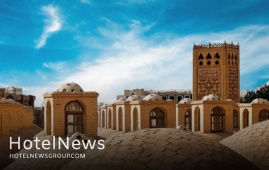
New legal boundaries have been defined for five historical properties, which are scattered across Yazd province. The Ministry of Cultural Heritage, Tourism, and Handicrafts has announced the exact legal boundaries of the properties in separate letters to the governor-general of the central province, IRIB reported on Tuesday. In addition to protecting historical sites, the demarcation projects are aimed to prevent further destruction and damage. Esfahanian Garden House, Eqbal Factory, Vazir Castle, Ezzatabad Castle, and Ezzatabad Kushk (small garden pavilion) are those demarcated recently. In July 2017, the historical structure of the city of Yazd was named a UNESCO World Heritage. Wedged between the northern Dasht-e Kavir and the southern Dasht-e Lut on a flat plain, the oasis city enjoys a very harmonious public-religious architecture that dates from different eras. Yazd is usually referred to as a delightful place to stay, or a “don't miss” destination by almost all of its visitors. The city is full of mudbrick houses that are equipped with innovative badgirs (wind catchers), atmospheric alleyways, and many Islamic and Iranian monuments that shape its eye-catching city landscape. It is a living testimony to the intelligent use of limited available resources in the desert for survival. Water is brought to the city by the qanat system. Each district of the city is built on a qanat and has a communal center. The use of earth in buildings includes walls and roofs by the construction of vaults and domes. Houses are built with courtyards below ground level, serving underground areas. Wind-catchers, courtyards, and thick earthen walls create a pleasant microclimate. Partially covered alleyways together with streets, public squares and courtyards contribute to a pleasant urban quality. The city escaped the modernization trends that destroyed many traditional earthen cities.
Create: Dec 29, 2021 Edit: Dec 29, 2021 Regional News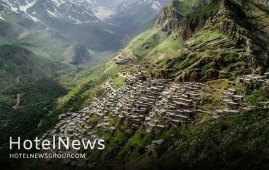
A team of archaeologists from Iran and Germany has carried out a field survey in Uramanat, an ancient rural region in western Iran, which earlier this year was named a UNESCO World Heritage. The survey was intended to shed new light on the history of Uramanat by unearthing remnants of historical monuments and relics, ISNA quoted the director of the World Heritage site as saying on Tuesday. It yielded the discovery of “several” archaeological sites and objects yet it resulted in a change in the chronological sequence of several previously-found ancient sites, Pouya Talebnia added. Moreover, several historical fortresses and their legal properties were demarcated during the survey, which was co-directed by Talebnia and Shelir Amelirad from Heidelberg University, the report said. Carried out during December and November, the survey also contributed to the enrichment of the “pottery bank” of Uramanat, Talebnia said. Stretched on the slopes of Sarvabad county, and shared between the provinces of Kordestan and Kermanshah, the rural area embraces dense and step-like rows of houses in a way that the roof of each house forms the yard of the upper one, a feature that adds to its charm and attractiveness. Last September, Hessam Mahdi, the representative of the International Council on Monuments and Sites (ICOMOS) said that he was “impressed” by the status of the rural landscape during his visit. He made the remarks on the sidelines of a visit to the western province of Kermanshah. “I am proud of being chosen to assess the case and traveling to Iran as I could visit the local people in the region.” Local officials and travel insiders believe that inscription of the property on the prestigious list of the UN body could jumpstart tourism in the region and also look at it as a tool for better conservation of its natural landscapes and unique cultural scenes for the next generations, saying its unique rural texture, architecture, lifestyle, and agriculture is a prominent example of the integration of man into nature. The Islamic Republic expects to reap a bonanza from its numerous tourist spots such as bazaars, museums, mosques, bridges, bathhouses, madrasas, mausoleums, churches, towers, and mansions, of which 26 are inscribed on the UNESCO World Heritage list. Under the 2025 Tourism Vision Plan, Iran aims to increase the number of tourist arrivals from 4.8 million in 2014 to 20 million in 2025. The latest available data show eight million tourists visited the Islamic Republic during the first ten months of the past Iranian calendar year (ended March 20).
Create: Dec 22, 2021 Edit: Dec 22, 2021 Regional News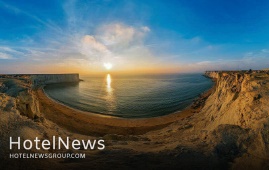
he development of Sistan-Baluchestan through tourism can help the region address its challenges, the deputy tourism chief of the southeastern province has announced. Through the development of tourism, a peace project can be pursued with the neighboring countries in the region, CHTN quoted Mojtaba Mirhosseini as saying on Tuesday. To date, tourism activists in the province have focused on activities for the sustainable development of tourism, which is highly commendable, the official added. The port of Chabahar has the potential to become the maritime tourism capital of Iran, and also the northern region of the province has the potential to become the historical tourism capital of the country, which with the right planning and building of necessary infrastructure, can be achieved, he noted. In order to increase the demand for visiting the province, its attractions and beauty need to be presented as much as possible, he explained. SEO and web marketing are among the most effective digital marketing tools in tourism and can help introduce more people to the province and local businesses, he mentioned. He also noted that organizing fam tours for Iranian tourism activists and media people significantly changed people’s perceptions of the region. Last year, former Cultural Heritage, Tourism, and Handicrafts Minister Ali-Asghar Mounesan said that the development of the travel industry across Sistan-Baluchestan province is among the top priorities for the ministry. “I am interested in Sistan-Baluchestan, and the development of this province is a priority for this ministry and the government,” the former minister stated. “The majority of my travels during my tenure has been to Sistan-Baluchestan, which I consider as a safe province with significant values in terms of culture, history, handicrafts, and tourism.” The collective province -- Sistan in the north and Baluchestan in the south -- accounts for one of the driest regions of Iran with a slight increase in rainfall from east to west, and an obvious rise in humidity in the coastal regions. In ancient times, the region was a crossword of the Indus Valley and the Babylonian civilizations. The province possesses special significance because of being located in a strategic and transit location, especially Chabahar which is the only ocean port in Iran and the best and easiest access route of the middle Asian countries to free waters. The vast province is home to several distinctive archaeological sites and natural attractions, including two UNESCO World Heritage sites, namely Shahr-e-Soukhteh (Burnt City) and Lut desert.
Create: Dec 22, 2021 Edit: Dec 22, 2021 Regional News
A group of 10 Iraqi tour operators and travel agents along with their Iranian fellows are to commence a familiarization tour across the northern province of Golestan, the provincial tourism chief has announced. The group will start a four-day familiarization tour on Tuesday with the aim of getting acquainted with the province’s tourism potential as a travel destination, Ahmad Tajari said on Monday, CHTN reported. During the tour, there will be specialized meetings to exchange information and to build a stronger relationship between both sides, the official added. Both sides will also visit tourism, cultural heritage, and handicraft sites to learn more about their capabilities in these areas, he noted. The tour will also highlight the province’s strengths, including its natural, cultural, historical, handcrafts, agricultural tourism, and other assets, he mentioned. The Golestan province, with its ethnic diversity, various climate and potential in handicrafts and cultural heritage, has a very high potential for foreign tourism, and Iraq is one of its important target countries, the official explained. Last week, several Iraqi travel insiders and tour operators requested Iran to waive visa requirements for Iraqi nationals who want to enter the Islamic Republic via land borders. Earlier this year the two neighbors agreed to abolish visa requirements for air travelers. The announcement came after Iranian President Seyyed Ebrahim Raisi and Iraqi Prime Minister Mustafa al-Kadhimi met in Tehran, discussing various issues including visa waiver, a joint railway project, and increasing the level of trade. Before the coronavirus pandemic, Iraqi constituted Iran’s largest source of tourists. In return, hundreds of thousands of Iranian pilgrims head for the holy Iraqi cities of Najaf and Karbala each year to attend the Arbaeen pilgrimage, aka the Arbaeen trek, to mark an end to the 40-day mourning period following the martyrdom of Imam Hussein (AS), the grandson of Prophet Muhammad (PBUH). Golestan is reportedly embracing some 2,500 historical and natural sites, with UNESCO-registered Gonbad-e Qabus – a one-millennium-old brick tower – amongst its most famous. Narratives say the tower has influenced various subsequent designers of tomb towers and other cylindrical commemorative structures both in the region and beyond. The UNESCO comments that the tower bears testimony to the cultural exchange between Central Asian nomads and the ancient civilization of Iran.
Create: Nov 30, 2021 Edit: Nov 30, 2021 Regional News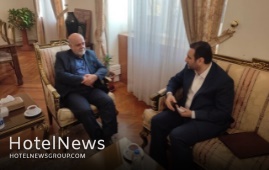
Iran is getting prepared to welcome more Iraqi sightseers, pilgrims, and medical travelers. "We are trying to re-organize and facilitate the arrival of potential Iraqi tourists who want to visit our country for various purposes including pilgrimage, medical treatment, and health," the deputy tourism minister said on Tuesday. "The Ministry of Cultural Heritage, Tourism and Handicrafts seeks to introduce Iraqi travelers to further lesser-known destinations and help increase their stay duration," ISNA quoted Ali-Reza Shalbafian as saying on Tuesday. Shalbafian made the remarks during a meeting with the Iranian Ambassador to Iraq, Iraj Masjedi, adding "Our main approach is to ease visa restrictions." Tehran and Baghdad in September agreed to ease tough visa restrictions as a step forward in broadening bilateral relations. The announcement came after Iranian President Seyyed Ebrahim Raisi and Iraqi Prime Minister Mustafa al-Kadhimi met in Tehran, discussing various issues including visa waiver, a joint railway project, and increasing the level of trade. Before the coronavirus pandemic, Iraqi constituted Iran’s largest source of tourists. In return, hundreds of thousands of Iranian pilgrims head for the holy Iraqi cities of Najaf and Karbala each year to attend the Arbaeen pilgrimage, aka the Arbaeen trek, to mark an end to the 40-day mourning period following the martyrdom of Imam Hussein (AS), the grandson of Prophet Muhammad (PBUH).
Create: Nov 27, 2021 Edit: Nov 27, 2021 Regional News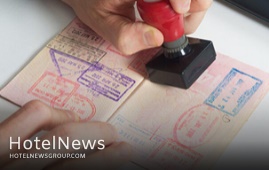
The Foreign Ministry Director-General for West Asia has said that Iran considers easing visa rules for Afghan nationals. "Facilitation of the legal entry of Afghan citizens into Iran is the best way to combat illegal entry, human trafficking, and many norm-breaking behaviors," ISNA quoted Seyyed Rasoul Mousavi as saying on Wednesday. "Today (Tuesday), only in Herat, 1509 people [Afghans] were granted entry visas to Iran," the top diplomat tweeted. Recently, Seyyed Hassan Mortazavi, Iran’s Deputy Ambassador to Afghanistan, said that twelve aid cargoes carrying Iranian aid have been delivered to the people of Afghanistan. He noted that the Leader of the Islamic Revolution has emphasized the continuation of humanitarian assistance to “the oppressed” people of Afghanistan. Mortazavi also noted that the humanitarian aid from the Islamic Republic to the people of Afghanistan has been continuing over the past three months, during the time that Afghanistan has been the scene of drastic political changes.
Create: Nov 27, 2021 Edit: Nov 27, 2021 Regional News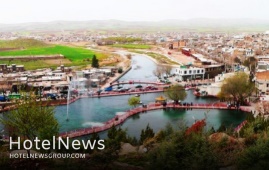
Nine tourism-related projects, which are planned to be carried out across the western province of Kermanshah are estimated to generate 135 jobs upon their completion, the provincial tourism chief has announced. The projects will be implemented in the cities of Kermanshah, Javanrud, Harsin, and Islamabad-e-Gharb, Jabbar Gohari said on Tuesday. A budget of 2.4 trillion rials ($58.4 million at the official exchange rate of 42,000 rials per dollar) will be channeled into the projects, which include accommodation centers, tourist complexes, traditional restaurants, and hotel hospitals, the official explained. Kermanshah embraces a variety of awe-inspiring historical sites, of which Bisotun and Taq-e Bostan are both on the UNESCO World Heritage list. Inscribed into the base of a towering cliff, Taq-e Bostan comprises extraordinary Sassanian bas-reliefs of ancient victorious kings divide opinions. Late afternoon is the best time to visit, as the cliff turns a brilliant orange in the setting sun, which then dies poetically on the far side of the duck pond. Bisotun is a patchwork of immense yet impressive life-size carvings depicting King Darius I and several other figures. UNESCO has it that Bisotun bears outstanding testimony to the important interchange of human values on the development of monumental art and writing, reflecting ancient traditions in monumental bas-reliefs.
Create: Nov 20, 2021 Edit: Nov 20, 2021 Regional News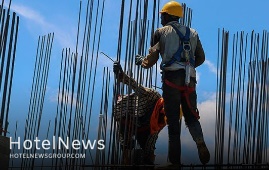
Private investors are now constructing a 5-star hotel, which according to local officials would be the “biggest” of its kind in the northwestern Ardabil province. “Construction operation of what would be the biggest five-star hotel in Ardabil province is ongoing in [the touristic region of] Aznav in Khalkhal county,” Khalkhal’s governor said on Tuesday. The seven-story hotel would have 350 beds in an area of 11,000 square meters, Masud Yeganeh said, CHTN reported. Back in January, the provincial tourism chief, Nader Fallahi, announced that more than 150 tourism-related projects are underway across the mountainous province. “The mentioned projects will prepare the province’s tourism sector for the post-coronavirus era when the number of tourists and travelers is expected to rise magnificently,” the official said. Sprawling on a high, windswept plateau, Ardabilis well-known for having lush natural beauties, hospitable people, and its silk and carpet trade tradition. It is also home to the UNESCO-registered Sheikh Safi al-Din Khanegah and Shrine Ensemble. The province is very cold in winter and mild in summer, attracting thousands every year. The capital city of Ardabilis usually recorded as one of the coldest cities in the country in winter.
Create: Nov 20, 2021 Edit: Nov 20, 2021 Regional News
A selection of craftspeople, travel insiders, and exhibitors from Sistan-Baluchestan are getting prepared to promote the southeastern Iranian province at the Expo 2020 Dubai, which is currently underway in the UAE. "[A selection of exhibitors from] Sistan-Baluchestan province will be attending the expo in Dubai, in [the month of] Bahman to present a variety of programs," the provincial tourism chief Alireza Jalalzaei said on Tuesday. A wide range of Sistan-Baluchestan's ancient handicrafts, live performances, and workshops, and introductions to cultural and natural destinations, and the archaeological sites is expected to take the center stage at the Iran pavilion during the event, the official explained. Visitors to the pavilion are offered to discover epitomes of the ancient land in terms of rituals, handicrafts, cultural heritage, and travel destinations. It also reveals more about medical tourism, novel startups, and off-the-beaten tracks. Many countries and companies are also looking to the expo - the first major global event open to visitors since the coronavirus pandemic - to boost trade and investment. According to organizers, the Expo, an exhibition of culture, technology, and architecture under the banner “Connecting Minds and Creating the Future”, is expected to be a demonstration of ingenuity, and a place where global challenges such as climate change, conflict, and economic growth can be addressed together. Iran expects to reap a bonanza from its numerous tourist spots such as bazaars, museums, mosques, bridges, bathhouses, madrasas, mausoleums, churches, towers, and mansions, of which 26 are inscribed on the UNESCO World Heritage list. The collective province -- Sistan in the north and Baluchestan in the south -- accounts for one of the driest regions of Iran with a slight increase in rainfall from east to west, and an obvious rise in humidity in the coastal regions. In ancient times, the region was a crossword of the Indus Valley and the Babylonian civilizations. The province possesses special significance because of being located in a strategic and transit location, especially Chabahar which is the only ocean port in Iran and the best and easiest access route of the middle Asian countries to free waters. The vast province is home to several distinctive archaeological sites and natural attractions, including two UNESCO World Heritage sites, namely Shahr-e-Soukhteh (Burnt City) and Lut desert.
Create: Oct 31, 2021 Edit: Oct 31, 2021 Regional News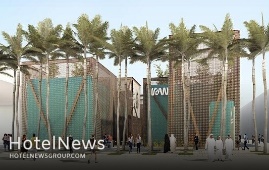
According to the Hotel News, The Association of Iranian Travel Agencies has invited domestic travel businesses to attend Iran pavilion at Expo 2020 Dubai, which is currently underway in UAE. Association of Iranian Travel Agencies Director Hormatollah Rafiei has called on [eligible] travel agencies to grasp “this golden opportunity” by attending the event in a space provided to tourism activists for free, Mehr reported on Tuesday. Visitors to the pavilion are offered to discover epitomes of the ancient land in terms of rituals, handicrafts, cultural heritage, and travel destinations. It also reveals more about medical tourism, novel startups, and off-the-beaten tracks. Many countries and companies are also looking to the expo - the first major global event open to visitors since the coronavirus pandemic - to boost trade and investment. According to organizers, the Expo, an exhibition of culture, technology, and architecture under the banner “Connecting Minds and Creating the Future”, is expected to be a demonstration of ingenuity, and a place where global challenges such as climate change, conflict, and economic growth can be addressed together. The Persian Gulf state has relaxed most coronavirus limitations but Expo requires face masks to be worn and for visitors over 18 to be vaccinated against, or test negative for, COVID-19. Iran expects to reap a bonanza from its numerous tourist spots such as bazaars, museums, mosques, bridges, bathhouses, madrasas, mausoleums, churches, towers, and mansions, of which 26 are inscribed on the UNESCO World Heritage list.
Create: Oct 20, 2021 Edit: Oct 20, 2021 Regional News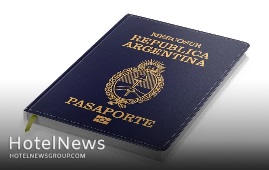
Argentina will start issuing gender-neutral passports to non-binary citizens, becoming the first Latin American country to do so. The cards will feature an ‘X’ in place of the traditional ‘M’ or ‘F’ gender descriptors. The issuance of the first gender-neutral passports was announced in a decree by President Alberto Fernandez on Tuesday, with a public announcement expected on Wednesday morning. Argentina’s Gender Identity Law was passed in 2012, and allowed citizens to change their gender without first undergoing psychiatric evaluation or physical transition. It also allowed them to identify as a non-binary third gender, though official documents such as ID cards, passports and tax forms still required them to choose from male or female. According to Fernandez’ decree, the new ‘X’ options will stand for: “non-binary, indeterminate, unspecified, undefined, not informed, self-perceived, not consigned; or another meaning with which the person who does not feel included in the masculine/feminine binomial could identify.” Argentina will be the first country in the region to issue such gender-neutral travel documents, though other countries around the world have done so for some time already. Certain US states allow non-binary people to identify as “X” on driver’s licenses or other forms of ID, and several European countries record the rare percentage of intersex births as a third category on birth certificates. The Netherlands issued its first gender-neutral passport in 2018 to a woman who was born intersex, raised male, and eventually transitioned to female, but still identified as intersex.
Create: Jul 24, 2021 Edit: Jul 24, 2021 International News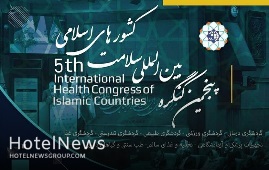
The 5th edition of the International Health Congress of Islamic Countries started in Tehran on Tuesday, aiming to find new opportunities for cooperation and development of health tourism among Muslim nations. Being held at IRIB International Conference Center, the congress is organized by the Health Tourism Development Center of Islamic Countries (HTDC) and supported by ministries, federations, institutions, and organizations in health tourism as well as private and governmental health service providers, the official website of the event announced. The three-day event has brought together seniors and experts from governmental and private sectors in the health tourism industry. The congress is being held in five specialized panel discussions of medical tourism, sports tourism, natural, wellness, and food tourism, medical and laboratory equipment, and nutrition and healthy food. The event started its official operations in 2015 with the aim of playing an effective role in developing economic relations and facilitating the networks between stakeholders in the health and health tourism industry. The developing health tourism industry is one of the most important fields of Iran’s travel sector, which is trying to prove its capabilities and capacities in attracting medical and health tourists to the country. Many domestic experts believe that medical tourism in Iran is a win-win opportunity both for the country and foreign patients, as they are offered affordable yet quality treatment services and the country gains considerable foreign currency. Iran’s two most popular medical tourist cities are Tehran and Mashhad, but the coronavirus outbreak has significantly reduced the number of travelers. Iran is one of the major destinations for health tourism in the region, and patients with 55 different nationalities, mostly from neighboring countries including Iraq, Kuwait, Bahrain, Qatar, Saudi Arabia, Oman, Pakistan, Afghanistan, Tajikistan, and Turkmenistan are seeking to use Iran’s services and facilities in this field. Iranian hospitals admitted nearly 70,000 foreign patients over the Iranian calendar year 1397 (March 2018 – March 2019) and it made an economic contribution of around $1.2 billion to the country, according to the medical tourism department at the Ministry of Health. In April 2018, the rotating presidency of the International Health Tourism Conference of Economic Cooperation Organization (ECO) was handed to the Islamic Republic for a three-year term. Mohammad Jahangiri who presides over a national center for developing health tourism said in May 2018 that Iran can annually earn $7 billion in medical and health tourism, though the sector now brings in only one-seventh or even lesser of the sum. The Islamic Republic has set its goals to exceed its yearly medical travelers to around 2 million in the Iranian calendar year 1404.
Create: Jul 17, 2021 Edit: Jul 17, 2021 Regional News
